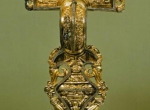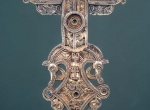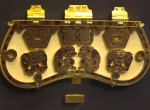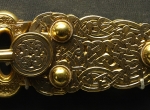Animal style
Animal style: a Migration Period style of ornamentation recognized by B. Salin in which zoomorphic motifs cover large areas of the decorated object; used to decorate brooches, belt ornaments, horse harness fittings, weapons, etc. B. Salin distinguished A.s. into Styles I, II and III. Style I derives from the Nydam style, dated to between the early 5th century and 475; in it the surfaces of objects are decorated with plant and geometric motifs - palmette, meander, etc., and the animal motifs (some of them fantastic, like the dolphin-eagle hybrid) appear only on the fringes of the composition. The Nydam style was inspired by the Roman provincial art; this is visible especially in finds of military belts from the Rhine and the Danube region, and has been explained as the result of the migration of Roman craftsmen. Style I took form around 475, or – if we take into account long-term use of objects with this dating – even around the mid-5th century, presumably without impact from nomad cultures (representations of birds of prey and horses). In Style I representations of beasts, usually placed near the edges of the object, are rendered with no attempt at realistic portrayal (e.g., different animal body parts are mixed-up - in German: Tiersalad), nevertheless, it is often possible to grasp the rhythm of the depictions and make out the larger whole. G. Haseloff carried out an in-depth study of Style I and proposed to separate it into phases A–D; these however, given our current knowledge, cannot be understood to correspond to individual chronological periods and should be treated as variants of Style I. Their characteristic features are the following: phase A – depictions of animal-human hybrids (German Tiermenschen), no zoomorphic figures in the central area of the composition, which is reserved for geometric or plant motifs, the more prominent features, especially the limbs and heads of the beasts are highlighted by using sculpture techniques (as in the relief brooch from Gummersmark); phase B – low relief, the bodies of beasts appear everywhere on the surface of the object, have distinct contours, often filled with hatching (e.g., the brooch from Vedstrup); phase C – the contours are of double or triple lines, the bodies of animals are often elongated into “ribbons”, and are in a relatively dense arrangement; phase D – beasts with ribbon-like bodies (of local importance only: Norway, western Denmark). Style I is used to decorate objects such as horn mounts, relief brooches, gold collar necklaces, weapons; it is observed in the Baltic Sea region, as well as in England, the Merovingian environment, among the →Thuringi, →Gepids and →Langobards, and disappears after mid-6th century; in some areas (e.g., Anglo-Saxon) its popularity lingers for a little longer. Style II took form in Scandinavia, during the latter half of the 6th c. and continued in use until the 7th c. In this style the beasts are depicted entire, often with an elongated ribbon body, interlaced, sometimes as an element of a heraldic motif, e.g., paired and flanking the central decorative motif. Basing of difference of detail M. Ørsnes separated Style II into Styles B-E. Encountered outside Scandinavia Style II is usually interpreted as the result of impact from Scandinavia, or even of migration from that region. Style II is mostly seen on objects associated with the military sphere, where it has an ideological content, but is also adapted in Christian iconography, e.g., gold-foil crosses present in burials in the Merovingian environment. Style III (Ørsnes F), observed in Scandinavia, is characteristic for the Late Vendel Period (it appears at the end of the Middle Vendel Period, before the end of the 7th c.) – and is visibly inspired by Hibernian and Anglo-Saxon art. (see also →Kerbschnitt Style)
BK
Literature: B. Salin, Die altgermanische Thierornamentik. Typologische Studie über germanische Gegenstände aus dem IV. bis IX. Jahrhundert, nebst einer Studie über irische Ornamentik, Stockholm 1904; M. Ørsnes, Form ogstil i sydskandinavien syngregermanske jærnalder, København 1966; G. Haseloff, Die germanische Tierornamentik der Völkerwanderungszeit. Studien zu Salin's Stil I, Berlin-New York 1981; K. Høilund Nielsen, Animal Style – a Symbol of Might and Myth. Salin’s Style II in a European Context, Acta Archaeologica 69, 1998, p. 1-52; K. Høilund Nielsen, Saxon art between interpretation and imitation: the influence of Roman, Scandinavian, Frankish, and Christian art on the material culture of the continental Saxons AD 400–1000, [in:], D.H. Green, F. Sigmund (eds.), The Continental Saxons from the Migration Period to the Tenth Century: an Ethnographic Perspective, San Marino 2003, p. 193-233; K. Høilund Nielsen, The Real Thing or Just Wannabes? Scandinavian-Style Brooches in the fifth and sixth Centuries, [in:] D. Quast (ed.) Foreigners in Early Medieval Europe. Thirteen International Studies on Early Medieval Mobility, Monographien des Römisch-Germanischen Zentralmuseums 78, Mainz 2009, p. 51-111; K. Høilund Nielsen, Animal Style and elite communication in the later 5th and 6th centuries, [in:] D. Quast (ed.), Weibliche Eliten in der Frühgeschichte/Female Elites in Protohistoric Europe, RGZM – Tagungen 10, Mainz 2011, p. 361-376.






